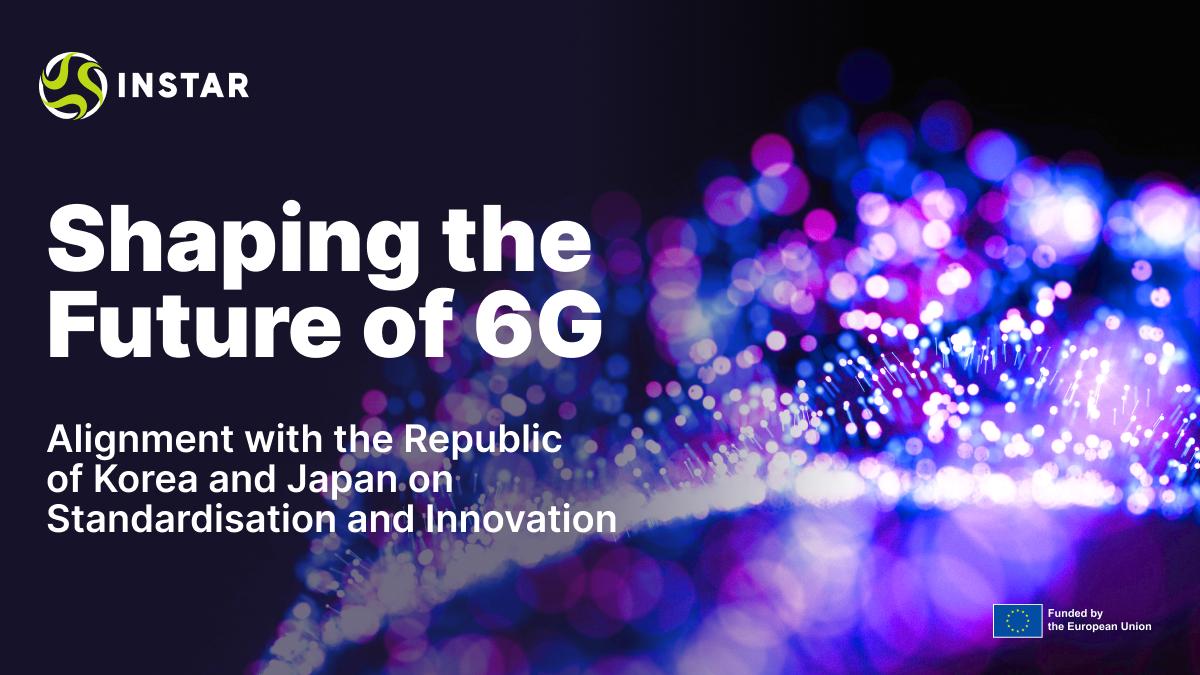On 2 June 2025, INSTAR convened an important webinar titled "Shaping the Future of 6G: Alignment with Republic of Korea & Japan on Standardisation and Innovation." The event brought together experts from the European Union, Republic of Korea, and Japan to discuss collaborative efforts in transitioning from 5G to 6G, emphasising standardisation and innovation opportunities. Framed within the EU’s Digital Partnerships with South Korea and Japan, speakers stressed that digital standardisation is now a matter of geopolitical interest and called for a shared vision and roadmap spanning 5G+/6G, AI, and cybersecurity.
The timing of the webinar followed the third EU‑Japan Digital Partnership Council and progress on the EU‑ROK Digital Partnership centred on removing unjustified barriers via standards, positioning the webinar to translate political commitments into concrete collaboration on research, innovation, and standardisation for 6G. The webinar highlighted the growing geopolitical importance of standardisation in the digital field and the EU's commitment to promoting its leadership and a human-centric vision for digital technologies. Digital partnerships with Korea and Japan, are instrumental in boosting industrial competitiveness, innovation, and resilience in emerging technologies such as AI, cybersecurity, quantum computing, and 6G. INSTAR's role is to foster alignment on common visions and roadmaps for ICT standardisation among like-minded partners.
Key insights from the presentations
The 6G Landscape and EU Strategy
- EU’s geopolitical vision: The EU seeks leadership and influence in global standardisation, with 6G as a central strand in EU‑Japan and EU‑Korea cooperation. The EU's 2022 Standardisation Strategy is a cornerstone for promoting leadership in international standardisation. These efforts are reinforced by the digital partnerships with Japan and Korea, aimed at boosting competitiveness and advancing research in critical areas like 6G.
- SNS JU’s role and timeline: The Smart Networks and Services Joint Undertaking is considered the EU’s public‑private engine for the 6G transition, and the next two years are critical for shaping technical specifications, with 3GPP Release 20 laying groundwork toward first normative standards in Release 21 around 2028.
- Achievements and themes: SNS JU projects have produced 1,135 standardisation contributions and secured 91 patents in the first two years. Open Source and AI are foundational design axes for 6G, with AI at parity with spectrum and architecture in influence. International “mirror projects” with the US, Japan, and ROK further extend impact.
EU‑Korea and EU‑Japan Activities
- ROK 6G strategy: MSIT’s (Ministry of Science and ICT) government‑led 6G R&D programme targets initial standardisation by 2025 and pre‑6G demos by 2026, emphasising software‑ and AI‑driven 6G, integrated sensing and communication (ISAC), and energy efficiency.
- 3GPP progress: 3GPP’s 6G progress includes the Stage‑1 IMT‑2030 use cases workshop held in May 2024 and the first TSG‑wide 6G workshop hosted by TTA in March 2025, with Release 20 studies covering TR 22.870 use case families such as AI, ISAC, ubiquitous connectivity, and industry/verticals.
- Japan’s focus: AI was identified as a key technology area, while urgent energy reductions were emphasized. Speakers noted Keidanren’s plan for a government “standardisation headquarters” to coordinate industry and talent, targeted to begin operating by Autumn 2025.
SNS JU International Projects
- EU‑ROK 6G‑ARROW: The presentation covered an AI‑native integrated RAN–Core architecture with device‑level AI/ML enhancements and RAN/Core optimisation, featuring an intercontinental Helsinki–Seoul testbed for semantic communications in robot control, alongside planned 3GPP contributions and Globecom demonstrations.
- EU‑Japan 6G‑MIRAI‑HARMONY: The EU‑Japan 6G‑MIRAI‑HARMONY effort focuses on a robust AI‑native 6G air interface, D‑MIMO, and next‑generation RAN aligned to 3GPP timelines to inform Release 20 and seed Release 21, supported by a shared data and benchmarking platform to advance collaborative AI/ML research.
Conclusions
The event demonstrated that achieving 6G requires not only technical breakthroughs but deep, sustained international collaboration anchored in shared principles and a common strategic vision. Key takeaways focused mainly on the:
- Role of open source: Open source was identified as a bridge from research to market standards, referencing the new ETSI Software Development Group for an Open Operator Platform aligned with GSMA/3GPP. Speakers also noted major Korean firms’ open‑source participation and TTA’s adoption of open APIs like GSMA CAMARA, while highlighting integration challenges with formal standards.
- Priority collaborations: Speakers converged on AI‑native design and sustainability/energy efficiency as top joint priorities, emphasising that sustainability gaps in 5G must be corrected as a core pillar for 6G across the EU, Japan, and Korea.
- Talent pipeline: The high entry barrier to standardisation demands structured training for early‑stage researchers and students to develop future experts, a view broadly shared by the panel.
Proposed actions
- Prioritise AI‑native design, sustainability, and open, interoperable architectures to maximise global 6G impact and competitiveness.
- Advance flagship cross‑regional R&D (e.g. 6G‑ARROW, 6G‑MIRAI‑HARMONY) as pre‑standardisation vehicles to validate concepts and align positions ahead of formal 3GPP contributions.
- Maintain and strengthen INSTAR’s task force dialogues. Promote the INSTAR-TTA joint PICS (Priorities for International Collaboration on Standards) in GISC 2025 (Global ICT Standards Conference), where several EU like-minded international partners will attend.
